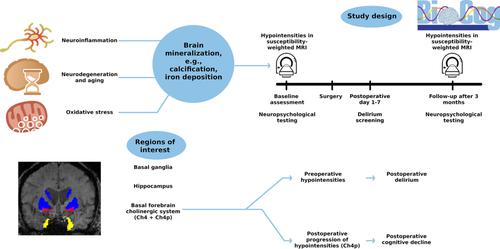当前位置:
X-MOL 学术
›
Eur. J. Nerosci.
›
论文详情
Our official English website, www.x-mol.net, welcomes your feedback! (Note: you will need to create a separate account there.)
An exploratory research report on brain mineralization in postoperative delirium and cognitive decline
European Journal of Neroscience ( IF 3.4 ) Pub Date : 2024-02-21 , DOI: 10.1111/ejn.16282 Florian Lammers‐Lietz 1, 2 , Friedrich Borchers 1 , Insa Feinkohl 3, 4 , Stefan Hetzer 5 , Cicek Kanar 1 , Frank Konietschke 6 , Gunnar Lachmann 1, 7 , Claudia Chien 8 , Claudia Spies 1 , Georg Winterer 1, 2, 9 , Laszlo Zaborszky 10 , Norman Zacharias 1, 9, 11 , Friedemann Paul 8, 12
European Journal of Neroscience ( IF 3.4 ) Pub Date : 2024-02-21 , DOI: 10.1111/ejn.16282 Florian Lammers‐Lietz 1, 2 , Friedrich Borchers 1 , Insa Feinkohl 3, 4 , Stefan Hetzer 5 , Cicek Kanar 1 , Frank Konietschke 6 , Gunnar Lachmann 1, 7 , Claudia Chien 8 , Claudia Spies 1 , Georg Winterer 1, 2, 9 , Laszlo Zaborszky 10 , Norman Zacharias 1, 9, 11 , Friedemann Paul 8, 12
Affiliation

|
Delirium is a severe postoperative complication associated with poor overall and especially neurocognitive prognosis. Altered brain mineralization is found in neurodegenerative disorders but has not been studied in postoperative delirium and postoperative cognitive decline. We hypothesized that mineralization‐related hypointensity in susceptibility‐weighted magnetic resonance imaging (SWI) is associated with postoperative delirium and cognitive decline. In an exploratory, hypothesis‐generating study, we analysed a subsample of cognitively healthy patients ≥65 years who underwent SWI before (N = 65) and 3 months after surgery (N = 33). We measured relative SWI intensities in the basal ganglia, hippocampus and posterior basal forebrain cholinergic system (pBFCS). A post hoc analysis of two pBFCS subregions (Ch4, Ch4p) was conducted. Patients were screened for delirium until the seventh postoperative day. Cognitive testing was performed before and 3 months after surgery. Fourteen patients developed delirium. After adjustment for age, sex, preoperative cognition and region volume, only pBFCS hypointensity was associated with delirium (regression coefficient [90% CI]: B = −15.3 [−31.6; −0.8]). After adjustments for surgery duration, age, sex and region volume, perioperative change in relative SWI intensities of the pBFCS was associated with cognitive decline 3 months after surgery at a trend level (B = 6.8 [−0.9; 14.1]), which was probably driven by a stronger association in subregion Ch4p (B = 9.3 [2.3; 16.2]). Brain mineralization, particularly in the cerebral cholinergic system, could be a pathomechanism in postoperative delirium and cognitive decline. Evidence from our studies is limited because of the small sample and a SWI dataset unfit for iron quantification, and the analyses presented here should be considered exploratory.
中文翻译:

术后谵妄和认知能力下降中脑矿化的探索性研究报告
谵妄是一种严重的术后并发症,与整体预后不良、尤其是神经认知预后不良相关。在神经退行性疾病中发现了大脑矿化改变,但尚未在术后谵妄和术后认知能力下降中进行研究。我们假设磁化率加权磁共振成像(SWI)中与矿化相关的低信号与术后谵妄和认知能力下降有关。在一项探索性假设生成研究中,我们分析了 65 岁以上认知健康且之前接受过 SWI 的患者的子样本(氮 = 65) 和术后 3 个月 (氮 = 33)。我们测量了基底神经节、海马和后基底前脑胆碱能系统 (pBFCS) 的相对 SWI 强度。对两个 pBFCS 亚区(Ch4、Ch4p)进行了事后分析。直到术后第七天对患者进行谵妄筛查。在手术前和手术后 3 个月进行认知测试。十四名患者出现谵妄。调整年龄、性别、术前认知和区域体积后,只有 pBFCS 低信号与谵妄相关(回归系数 [90% CI]:乙 = −15.3 [−31.6; −0.8])。调整手术持续时间、年龄、性别和区域体积后,pBFCS 相对 SWI 强度的围手术期变化与术后 3 个月的认知能力下降呈趋势水平相关(乙 = 6.8 [−0.9; 14.1]),这可能是由 Ch4p 次区域更强的关联驱动的(乙 = 9.3 [2.3; 16.2])。脑矿化,特别是脑胆碱能系统中的矿化,可能是术后谵妄和认知能力下降的病理机制。由于样本较小且 SWI 数据集不适合铁定量,我们研究的证据有限,此处提出的分析应被视为探索性的。
更新日期:2024-02-21
中文翻译:

术后谵妄和认知能力下降中脑矿化的探索性研究报告
谵妄是一种严重的术后并发症,与整体预后不良、尤其是神经认知预后不良相关。在神经退行性疾病中发现了大脑矿化改变,但尚未在术后谵妄和术后认知能力下降中进行研究。我们假设磁化率加权磁共振成像(SWI)中与矿化相关的低信号与术后谵妄和认知能力下降有关。在一项探索性假设生成研究中,我们分析了 65 岁以上认知健康且之前接受过 SWI 的患者的子样本(



























 京公网安备 11010802027423号
京公网安备 11010802027423号